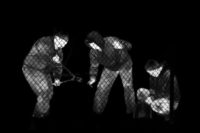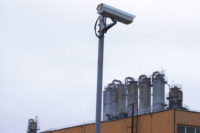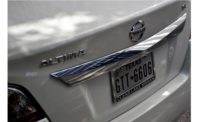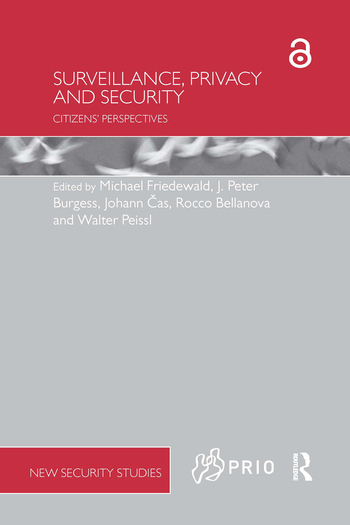Neither Rain Nor Dark of Night Will Stop Security




Wade Dorland, manager of operations and administration of The Seaway International Bridge Corporation, had a lighting problem he needed to solve for his security camera installation – only in his situation; it wasn’t a matter of too little light but creating too much light. The solution involved Bosch Aegis Super LED illuminators that worked with his existing cameras and were infrared capable.






Copper theft has become a major crime in the United States, thanks to record prices for the metal and hard economic times. As a New York Timesarticle put it, the current conditions have “spurred a resurgence in the past several months in the theft of common items that in better economic times might be overlooked — among them, catalytic converters from automobiles and copper wiring that is being stripped out of overhead power lines, tornado warning sirens, coal mines and foreclosed homes, where thieves sometimes tear down walls to get to copper pipes and wiring.”
This means that many companies now have to think about security in areas and in situations that may not have been in issue in the past. Utility company Gulf Power is one of those companies.
Jeff Taylor, CEO of Advanced Control Concepts (ACC), explains that the utility company determined that thermal security cameras provide a proven solution that helps them keep their vital facilities secure night and day and help fight the theft of copper wiring.
FLIR thermal cameras for all of Gulf Power’s level 3 substations provide clear imagery in total darkness so Gulf Power can monitor the substations’ fence lines and the surrounding area for approaching people and vehicles. ACC positioned the FLIR sensors at the corners of the perimeter for complete coverage of the 10-acre property. The FLIR sensors are designed to produce the appropriate pixels on target for integration with the video analytic equipment. Alarms are generated based on rule violations and the supporting video is sent to the central security control room for processing.
“This combination has proven superior to using the traditional perimeter motion detection and fence alarm equipment. In fact, Gulf Power has seen a complete elimination of false alarm problems due to the use of the new FLIR technology. It is a tremendous benefit to actually see and identify the alarm target. We can quickly determine if it is a valid threat or just an animal using the FLIR technology. This has increased our security while eliminating our false dispatches,” according to Charlie Griffith, an Investigator with Gulf Power.
Dominic DelloRusso, national program manager with Niscayah, also has clients who worry about copper theft, particularly from air conditioning units on rooftops. In these situations, DelloRusso installs wireless Videofied motion detection systems with a built-in camera.
What DelloRusso likes about using motion detection on rooftops is that when the sensor is tripped, the camera will film ten seconds of live action. This way, he can see immediately if the problem is a burglar or something blowing in the wind. “We mount the camera on a pole and put the pole in a five-gallon bucket of concrete,” he says. “That way we can move the cameras around the roof to find a location that is less affected by elements like the wind or nearby trees while monitoring the A/C units.”
Obviously, preventing copper theft is not the only reason companies need security cameras, but since copper theft takes place in areas where the outdoor environment can be less than ideal, setting up security systems presents unique challenges. But any outdoor camera could be subject to harsh conditions.
According to Pete DeAngelis, president and CEO of IQinVision, there are different types of harsh conditions to consider:
• Harsh Imaging. Such conditions here span the gamut from low/no light to weather (snow/rain/fog), to wind to object speeds, etc. Every one of these challenges has multiple possible ways to mitigate based upon the rest of the environment, the system requirements and the dollars available to spend on the mitigation.
• Harsh Physical Conditions. These conditions include an explosive environment like a refinery or an oil platform, a hot, humid tropical environment, or an area of extreme cold.
The primary issue when installing a camera in an area that doesn’t have ideal conditions is to make sure they function properly. Ed Thompson, chief technology officer with DVTel, says that one of the major considerations is the lighting in the area – either there is not enough light or the light is bad. He says the newest technologies available help to overcome a lot of the lighting problems, including wide dynamic range, true day/night sensors and digital slow shutter speed for longer exposure time.
Even in daylight, there can be lighting-related problems, Thompson adds, such as a rising or setting sun in the video. Positioning the camera so it isn’t focusing on sunlight can solve this problem, Thompson says. Also, Manny Patel of CommPort suggests a sun shield over the camera so the sun isn’t pounding on the lens.
Wade Dorland, manager of operations and administration of The Seaway International Bridge Corporation, had a lighting problem he needed to solve for his security camera installation – only in his situation; it wasn’t a matter of too little light but creating too much light.
“We operate an international crossing composed of a two bridge system,” Dorland explains. “Like any bridge or transportation infrastructure there are areas outside of the normal traffic flow areas that need to be monitored for security purposes. With a bridge there are access points that are specifically used for maintenance underneath the structure. Restricting access and ongoing monitoring of these areas has been an area of focus and a technical challenge.”
One of the challenges that Dorland’s group faced was understanding and addressing the concerns of the other area residents who have buildings and homes in the vicinity of the bridges. One particular concern for residents is the night time light levels. “I’m sure that we have all seen security implementations where at night time the area is blanketed in flood lights giving great visibility for camera monitoring,” he says. “Obviously, if you are within eye shot of those floodlights and trying to sleep it can be difficult. Similarly, there are triggered floodlight setups that only come on when a motion sensor is set off. Again, when those come on they make sleeping difficult for residents and with false alarms resulting from weather or other factors there will be incidents that are not security events triggering the lights.”
Initially, Dorland used a triggering system for the flood lights as an alternative to full lighting. However, this created three issues that showed triggering floodlights was not an optimal solution. First was the false alarm impact. Second, with a triggered lighting system, the time when you are most aware that you have a burned out light is when an alarm is triggered and you can’t see anything. And third, seeing a black screen at night time on a security monitor desensitized the monitoring of the area by staff.
“We came to the current solution by happenstance of working on another unrelated project with Bosch personnel,” Dorland says. “While taking a break we started to talk about this particular challenge and I originally asked their opinion on thermal imaging that I had seen elsewhere. The Bosch rep told me about the Aegis Super LED illuminators as an option. The illuminators worked with our existing cameras that were infrared capable. After seeing the video samples, I was convinced.”
Now, Dorland’s security staff can now look at a screen that is lit up like daylight in the areas they monitor and see all activity 24 hours a day. The infra-red light sent out by the illuminators is invisible and to the neighbors, the area appears dark at night.
Of course, there is more than a lack of illumination (or creating too much) when it comes to dealing with the challenges of outdoor camera surveillance.
Geographical location is going to play a role in outdoor camera installation. An installation on the Atlantic coastline will face different environmental conditions than an installation in the arid Southwest. The environmental conditions will determine the type of housing the camera is in, says Willem Ryan, senior product manager with Bosch.
The first consideration is how the camera is certified under the Intrusion Protection (IP) rating. Typically, Ryan explains, the IP rating gives a particular camera a rating protection against liquids and solids (like dust). The different ratings provide a description of what it protects against. An IP rating that begins with the number 6 provides a level of protection for conditions in outdoor applications. IP 68 is the highest rating and withstands the toughest environmental situations. In fact, Ryan says, a camera with an IP 68 rating can withstand long periods of submersion in water.
Also think about temperature swings in the region. Different cameras have different certified operating temperature is for the surveillance camera. Ryan advises to check both the high and low recommendations for the camera to make sure the camera will work in the climate where it will be installed. For example, can the camera system survive the temperature swings of a Midwestern state that dips well below zero in the winter and hits triple digits in the summer?
The next consideration to take into account is the type of housing in terms of material that the surveillance camera is enclosed in. Physical conditions usually require a specialized enclosure or mounting, says DeAngelis. The types of enclosures include nitrogen purged enclosures for very wet environments, blast-proof enclosures, spark-free enclosures and marine enclosures for brackish and saltwater environments.
There may be some corrosive factors to where the camera is being installed. A location near the ocean or in a tropical setting is going to be subjected to saltwater, and saltwater corrodes metal easily. It is important to look at all the different options available, in materials and in paint coatings. Is it is a situation where plastic is a better option than metal? Or will aluminum be a more optimal solution than stainless steel?
Situations like fog or sandstorms or high smog levels are a difficult environmental situation, simply because if the human eye has trouble seeing into the distance, so will the camera. In instances like this, a thermal camera or a motion sensor might be the best options, particularly if the camera is installed in an area that has regular instances of low visibility.
Cameras that are installed near utilities or in chemically hazardous locations will need to meet explosion proof certification. If the airborne materials are combustible and there is any spark or heat increase, an explosion can occur. In that type of environment, law mandates surveillance cameras that meet the explosion proof certification code. The certification is based on the type of hazard in the environment, so the camera doesn’t cause an explosion.
Perhaps not surprisingly, the biggest challenge in installing camera security is anticipating weather conditions. If it is raining, you don’t want the camera to get wet. Nor do you want a wet enclosure to put the camera in: this can cause condensation that obscures the video. Snow presents similar challenges as rain.
There is also the issue of getting power to the cameras if they are operating in isolated areas – or to keep the cameras operating in times of a power outage and during severe weather. In those situations, a battery-operated camera system may be the answer.
Sean O’Keefe, president of Texana, used Videofied’s battery-operated motion sensor system when one of his clients, a utility company, wanted a system installed in swamplands at the Louisiana-Texas border. “The area was hot, humid and muggy,” says O’Keefe. “When we were installing the system, there was a substation there with so much electrical current going through it that you couldn’t touch the poles for the static electricity.” With all that electrical interference going on, O’Keefe was concerned the surveillance system wouldn’t work, but there hasn’t been a problem. “Even when a hurricane came through, the system continued to work for a considerable period of time.”
What security personnel need to consider when installing a security system outdoors will be partly determined by the specific challenges of the area. In high wind areas, DeAngelis says, you need to make sure your anchors are secure enough to withstand the winds so the equipment doesn’t get blown away. Also, in a high-wind environment, if the camera is not locked on a stable surface, the quality of the image could be of a lesser quality.
If the camera is located in an area with frequent precipitation, cameras with a flat window is the best option. Flat windows are preferred because they won’t capture moisture like a dome. If possible, try to get a system with a wiper to always keep the viewing area clean. Wipers are also a good option in areas with frequent dust storms to get rid of the dirt and debris that settles on the lens.
Whenever possible, the camera should be situated so it isn’t triggered by tree branches.
In areas where there are heavy snowfalls, hurricanes, or flooding, installing a camera with an IP rating of 68 – the highest rating – will ensure the system continues to work in severe conditions.
And finally, it all comes back again to lighting. Ryan recommends adding some kind of security lighting to the camera system to get the best image possible in all conditions.
Looking for a reprint of this article?
From high-res PDFs to custom plaques, order your copy today!








